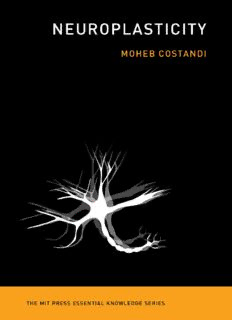
Neuroplasticity (The MIT Press Essential Knowledge series) PDF
Preview Neuroplasticity (The MIT Press Essential Knowledge series)
NEUROPLASTICITY The MIT Press Essential Knowledge Series Auctions, Timothy P. Hubbard and Harry J. Paarsch UnderstandingBeliefs, Nils J. Nilsson Cloud Computing, Nayan Ruparelia Computing: A Concise History, Paul E. Ceruzzi The Conscious Mind, Zoltan L. Torey Crowdsourcing, Daren C. Brabham Free Will, Mark Balaguer Information and the Modern Corporation, James W. Cortada Intellectual Property Strategy, John Palfrey The Internet of Things, Samuel Greengard Memes in Digital Culture, Limor Shifman Metadata, Jeffrey Pomerantz MOOCs, Jonathan Haber Neuroplasticity, Moheb Costandi Open Access, Peter Suber Paradox, Margaret Cuonzo Self-Tracking, Gina Neff and Dawn Nafus Waves, Frederic Raichlen NEUROPLASTICITY MOHEB COSTANDI The MIT Press Cambridge, Massachusetts London, England © 2016 Massachusetts Institute of Technology All rights reserved. No part of this book may be reproduced in any form by any electronic or mechanical means (including photocopying, recording, or information storage and retrieval) without permission in writing from the publisher. Library of Congress Cataloging-in-Publication Data Names: Costandi, Moheb. Title: Neuroplasticity / Moheb Costandi. Description: Cambridge, MA : The MIT Press, 2016. | Series: The MIT Press essential knowledge series | Includes bibliographical references and index. Identifiers: LCCN 2016002722 | ISBN 9780262529334 (pbk. : alk. paper) Subjects: LCSH: Neuroplasticity. | Neural transmission. | Nervous system—Physiology. Classification: LCC QP364.5 .C67 2016 | DDC 573.854—dc23 LC record available at http://lccn.loc.gov/2016002722 ISBN: 978-0-26252933-4 EPUB 3.0 CONTENTS Series Foreword Preface 1 Introduction 2 Sensory Substitution 3 Developmental Plasticity 4 Synaptic Plasticity 5 Adult Neurogenesis 6 Brain Training 7 Nerve Injury and Brain Damage 8 Addiction and Pain 9 Lifelong Brain Changes 10 Conclusion Notes Glossary Further Reading Index SERIES FOREWORD The MIT Press Essential Knowledge series offers accessible, concise, beautifully produced pocket-size books on topics of current interest. Written by leading thinkers, the books in this series deliver expert overviews of subjects that range from the cultural and the historical to the scientific and the technical. In today’s era of instant information gratification, we have ready access to opinions, rationalizations, and superficial descriptions. Much harder to come by is the foundational knowledge that informs a principled understanding of the world. Essential Knowledge books fill that need. Synthesizing specialized subject matter for nonspecialists and engaging critical topics through fundamentals, each of these compact volumes offers readers a point of access to complex ideas. Bruce Tidor Professor of Biological Engineering and Computer Science Massachusetts Institute of Technology Preface In recent years, researchers have made major advances in their understanding of how the brain works. Neuroscience offers both promises and perils, so public interest in it has grown enormously, because of the potential and promises that it offers, and one neuroscientific concept in particular has captured the public imagination: neuroplasticity, or change in the nervous system. Sixty years ago, the idea that nervous tissue can change was anathema to neuroscience. It was widely believed that the mature brain is a fixed structure and, therefore, that “you can’t teach an old dog new tricks.” This dogma has since been overturned by a huge body of research which shows not only that the brain can change, but also that it changes continuously throughout life, in one way or another, in response to everything we do and every experience we have. Neuroplasticity is a catch-all term referring to the many different ways in which the nervous system can change. It is ill-defined by neuroscientists, who use it to describe a wide variety of phenomena. Among the general public, the concept is generally misunderstood, and misconceptions about what neuroplasticity is, and what it is capable of, are rife. This book summarizes essential knowledge about neuroplasticity for the general reader, focusing on key experimental findings and the methods and technologies used to obtain them, and on how our thinking about the brain has evolved over time. Each chapter of the book is devoted to research into one particular mode of neuroplasticity. After offering a historical perspective, it describes the changes that occur during brain development; the changes that occur in the brains of blind and deaf people; the mechanisms of synaptic plasticity that underlie learning; the formation of new cells in the adult brain; how different types of training, such as learning to play a musical instrument or speak a foreign language, alter the brain; how neuroplasticity goes awry in addiction and pain states; and the key brain changes associated with different stages of life. The concluding chapter summarizes key points, describes several newly discovered forms of plasticity, and explores some of the many questions that remain to be answered. The mechanisms of neuroplasticity are so many, and so diverse, that one could not hope to cover the whole subject in such a small book. Nevertheless, this volume should give the reader a good overview of what we know about neuroplasticity, as well as a solid understanding of some key neuroscientific principles, knowledge of important historical developments in the field, and some insight into the scientific process.
